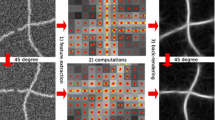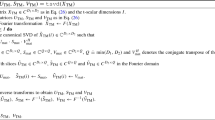Abstract
Spherical harmonics are widely used in 3D image processing due to their compactness and rotation properties. For example, it is quite easy to obtain rotation invariance by taking the magnitudes of the representation, similar to the power spectrum known from Fourier analysis. We propose a novel approach extending the spherical harmonic representation to tensors of higher order in a very efficient manner. Our approach utilises the so called tensorial harmonics [1] to overcome the restrictions to scalar fields. In this way it is possible to represent vector and tensor fields with all the gentle properties known from spherical harmonic theory. In our experiments we have tested our system by using the most commonly used tensors in three dimensional image analysis, namely the gradient vector, the Hessian matrix and finally the structure tensor. For comparable results we have used the Princeton Shape Benchmark [2] and a database of airborne pollen, leading to very promising results.
Preview
Unable to display preview. Download preview PDF.
Similar content being viewed by others
References
Reisert, M., Burkhardt, H.: Efficient tensor voting with 3d tensorial harmonics. In: IEEE Computer Society Conference on Computer Vision and Pattern Recognition Workshops, 2008. CVPRW 2008, pp. 1–7 (2008)
Shilane, P., Min, P., Kazhdan, M., Funkhouser, T.: The princeton shape benchmark. In: Shape Modeling and Applications, pp. 167–178 (2004)
Reisert, M.: Group Integration Techniques in Pattern Analysis - A Kernel View. PhD thesis, Albert-Ludwigs-Universität Freiburg (2008)
Kazhdan, M., Funkhouser, T., Rusinkiewicz, S.: Rotation invariant spherical harmonic representation of 3D shape descriptors. In: Symposium on Geometry Processing (June 2003)
Kostelec, P.J., Rockmore, D.N.: S2kit: A lite version of spharmonickit. Department of Mathematics. Dartmouth College (2004)
Healy, D.M., Rockmore, D.N., Moore, S.S.B.: Ffts for the 2-sphere-improvements and variations. Technical report, Hanover, NH, USA (1996)
Green, R.: Spherical harmonic lighting: The gritty details. In: Archives of the Game Developers Conference (March 2003)
Rose, M.: Elementary Theory of Angular Momentum. Dover Publications (1995)
Brink, D.M., Satchler, G.R.: Angular Momentum. Oxford Science Publications (1993)
Reisert, M., Burkhardt, H.: Second order 3d shape features: An exhaustive study. C&G, Special Issue on Shape Reasoning and Understanding 30(2) (2006)
Ronneberger, O., Wang, Q., Burkhardt, H.: 3D invariants with high robustness to local deformations for automated pollen recognition. In: Hamprecht, F.A., Schnörr, C., Jähne, B. (eds.) DAGM 2007. LNCS, vol. 4713, pp. 425–435. Springer, Heidelberg (2007)
Ronneberger, O., Burkhardt, H., Schultz, E.: General-purpose Object Recognition in 3D Volume Data Sets using Gray-Scale Invariants – Classification of Airborne Pollen-Grains Recorded with a Confocal Laser Scanning Microscope. In: Proceedings of the International Conference on Pattern Recognition, Quebec, Canada (2002)
Morse, P.M., Feshbach, H.: Methods of Theoretical Physics, Part II. McGraw-Hill, New York (1953)
Author information
Authors and Affiliations
Editor information
Editors and Affiliations
Rights and permissions
Copyright information
© 2009 Springer-Verlag Berlin Heidelberg
About this paper
Cite this paper
Skibbe, H., Reisert, M., Ronneberger, O., Burkhardt, H. (2009). Increasing the Dimension of Creativity in Rotation Invariant Feature Design Using 3D Tensorial Harmonics. In: Denzler, J., Notni, G., Süße, H. (eds) Pattern Recognition. DAGM 2009. Lecture Notes in Computer Science, vol 5748. Springer, Berlin, Heidelberg. https://doi.org/10.1007/978-3-642-03798-6_15
Download citation
DOI: https://doi.org/10.1007/978-3-642-03798-6_15
Publisher Name: Springer, Berlin, Heidelberg
Print ISBN: 978-3-642-03797-9
Online ISBN: 978-3-642-03798-6
eBook Packages: Computer ScienceComputer Science (R0)




